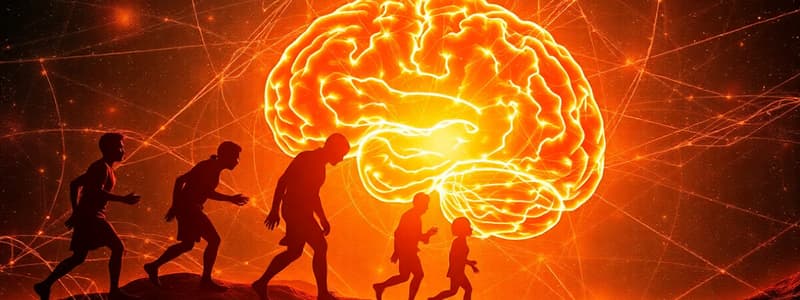Podcast
Questions and Answers
What do proximate explanations of altruism primarily focus on?
What do proximate explanations of altruism primarily focus on?
- The evolutionary functions of altruistic behavior
- The immediate psychological motivations behind altruism (correct)
- Cultural influences on altruistic actions
- Long-term benefits associated with helping others
What is the ultimate function of altruistic behavior from an evolutionary perspective?
What is the ultimate function of altruistic behavior from an evolutionary perspective?
- To build social networks and alliances
- To ensure long-term survival and reproductive success (correct)
- To gain external rewards and recognition
- To increase immediate satisfaction
How does natural selection shape altruistic behavior?
How does natural selection shape altruistic behavior?
- By favoring behaviors that improve individual reproductive chances (correct)
- By creating a conscious desire for external rewards
- By promoting competition over cooperation
- By encouraging cultural norms against helping others
Which of the following best defines kin selection?
Which of the following best defines kin selection?
What role does oxytocin play in altruistic behavior?
What role does oxytocin play in altruistic behavior?
What can undermine the benefits of performing altruistic acts?
What can undermine the benefits of performing altruistic acts?
Which explanation emphasizes the unconscious mechanisms motivating altruistic behavior?
Which explanation emphasizes the unconscious mechanisms motivating altruistic behavior?
What is mutualism in the context of altruism?
What is mutualism in the context of altruism?
What is the primary driver behind the evolutionary change rate within a species?
What is the primary driver behind the evolutionary change rate within a species?
Which concept refers to the understanding of goals that individuals pursue as a result of natural selection?
Which concept refers to the understanding of goals that individuals pursue as a result of natural selection?
How does kin selection influence behavior according to evolutionary theories?
How does kin selection influence behavior according to evolutionary theories?
What is the difference between proximate and ultimate causes in understanding behavior?
What is the difference between proximate and ultimate causes in understanding behavior?
Which concept describes the ability of an organism to adapt to varying environmental conditions?
Which concept describes the ability of an organism to adapt to varying environmental conditions?
What is a key characteristic of mutualism in evolutionary terms?
What is a key characteristic of mutualism in evolutionary terms?
What trade-off might exist for species with higher rates of evolutionary change?
What trade-off might exist for species with higher rates of evolutionary change?
In evolutionary biology, what does the term 'conflict of interest' typically refer to?
In evolutionary biology, what does the term 'conflict of interest' typically refer to?
What does the payoff table indicate about player A's decision-making under mutualism?
What does the payoff table indicate about player A's decision-making under mutualism?
In terms of social optimum, what is the most favorable strategy for player A?
In terms of social optimum, what is the most favorable strategy for player A?
What does negative frequency-dependence in a population imply?
What does negative frequency-dependence in a population imply?
What challenge does group functionalism encounter in evolution?
What challenge does group functionalism encounter in evolution?
Which statement best describes the evolutionary stable strategy (ESS) based on the payoff matrix?
Which statement best describes the evolutionary stable strategy (ESS) based on the payoff matrix?
How does kin selection influence reproductive strategies?
How does kin selection influence reproductive strategies?
Which of the following reflects the ultimate causes behind cooperative behavior?
Which of the following reflects the ultimate causes behind cooperative behavior?
What does a payoff of -4 indicate for player A if player B defects?
What does a payoff of -4 indicate for player A if player B defects?
Flashcards
Cognitive Science Focus
Cognitive Science Focus
Cognitive science studies how individuals process information, regardless of the goal.
Social Science Emphasis
Social Science Emphasis
Social science examines social phenomena as the results of individual actions and interactions, considering goals like safety and friendship.
Evolutionary Theory's Role
Evolutionary Theory's Role
Evolutionary theory explains the goals individuals pursue, as these are shaped by natural selection.
Life History
Life History
Signup and view all the flashcards
Trade-off
Trade-off
Signup and view all the flashcards
Evolutionary Change Rate Factor
Evolutionary Change Rate Factor
Signup and view all the flashcards
Phenotypic Plasticity
Phenotypic Plasticity
Signup and view all the flashcards
Environment of Evolutionary Adaptedness (EEA)
Environment of Evolutionary Adaptedness (EEA)
Signup and view all the flashcards
Proximate Explanations
Proximate Explanations
Signup and view all the flashcards
Ultimate Explanations
Ultimate Explanations
Signup and view all the flashcards
Altruism
Altruism
Signup and view all the flashcards
Intrinsic Motivation
Intrinsic Motivation
Signup and view all the flashcards
Evolutionary Psychology
Evolutionary Psychology
Signup and view all the flashcards
Reproductive Fitness
Reproductive Fitness
Signup and view all the flashcards
Neurochemicals (e.g., oxytocin, dopamine)
Neurochemicals (e.g., oxytocin, dopamine)
Signup and view all the flashcards
Risk of appearing inauthentic in altruistic actions
Risk of appearing inauthentic in altruistic actions
Signup and view all the flashcards
Social Optimum
Social Optimum
Signup and view all the flashcards
Evolutionarily Stable Strategy (ESS)
Evolutionarily Stable Strategy (ESS)
Signup and view all the flashcards
Negative Frequency-dependence
Negative Frequency-dependence
Signup and view all the flashcards
Cooperators, defectors
Cooperators, defectors
Signup and view all the flashcards
Payoff matrix
Payoff matrix
Signup and view all the flashcards
Mutant
Mutant
Signup and view all the flashcards
Evolutionary Stability
Evolutionary Stability
Signup and view all the flashcards
Group Functionalism
Group Functionalism
Signup and view all the flashcards
Study Notes
Human Behavior, Cultures, and Societies - Class 4
- Cognitive science focuses on how individuals process information, regardless of the ultimate goal.
- Key processes include detecting stimuli, analyzing signals (e.g., language), and making decisions.
- Social science examines how individuals interact and the aggregate consequences of those interactions.
- Understanding goals like safety, food, friendship, love, and status is crucial.
- Evolutionary theory is essential because goals are products of natural selection. A good understanding of natural selection is required.
Key Notions
- Life history trade-offs
- Adaptive (phenotypic) plasticity
- Environment of Evolutionary Adaptedness (EEA)
- Ultimate and proximate causes
- Conflict of interest
- Evolutionary Stable Strategy (ESS)
- Intrinsic and extrinsic motivation
Rate of Evolutionary Change
- Rate of evolutionary change primarily depends on generation time.
- Species with shorter generation times evolve faster.
- Phenotypic plasticity evolves in species with a longer generation time compared to environmental change rates.
- Phenotypic plasticity is less useful for species that can adapt genetically quickly.
Why is that after all?
- Phenotypic plasticity is not favored when generation time is fast compared to environmental change.
- There are enough generations during stable environmental periods to favor specialized genotypes.
- Specialized genotypes outperform plastic genotypes because they are well-suited to current conditions, but plasticity comes with costs.
- Selection favors specialized genotypes in each environmental phase.
Evolutionarily Stable Strategies (ESS)
- No single "optimal" strategy can be defined in scenarios involving multiple interacting individuals.
- Game theory was introduced to biology to deal with such situations.
- Nash equilibrium describes a situation where no alternative strategy is strictly better against the resident strategy and, in turn, is unbeatable.
- A strategy is an ESS if there is no rare mutant able to increase in frequency by natural selection when fixed in the population.
Examples
- Feeding or checking for predators (with others): The optimal individual strategy depends on what others are doing (e.g., if everyone else is vigilant, I can afford to eat).
- Prisoner's dilemma: A classic game theory study that shows how individual self-interest can lead to suboptimal outcomes for the group, even under cooperation. Average payoff under ESS is less when cooperating.
- Snowdrift game: Similar to the prisoner's dilemma, cooperation is not always the best and is not always an ESS.
Negative Frequency-Dependence
- In some cases, the relative dominance of a strategy shifts based on how many individuals adopt a particular strategy.
- Cooperators are favored when they are rare, defectors are favored when they are rare. Intermediate frequency at equilibrium.
Proximate versus Ultimate Explanations
- Proximate explanations focus on immediate mechanisms (neural, hormonal) producing behaviors.
- Examples include feelings of satisfaction or motivations for cooperation.
- Ultimate explanations look at evolutionary functions and adaptive benefits of behaviors (e.g., reproduction, survival of kin).
Real Altruism
- How do we explain anonymous donations?
- Real altruism exists outside of simple reputation management, such as in buddhist philosophy.
- Intrinsic motivation to be altruistic exists and can be separate from reputation gains. Building an altruistic robot requires programming it to care genuinely about others, even when there is no immediate benefit or reputational reward.
Acts of Altruism Between Species
- Evolutionary mismatch may account for altruistic acts. Behaviors evolved to solve ancestral problems may be maladaptive now.
- The concept of evolutionary mismatch applies to species showing altruistic behaviors to each other which did not co-evolve.
- Whales and dolphins protecting humans demonstrate potential evolutionary mismatch issues.
Cooperation
- Three mechanisms for cooperation:
- Kin selection (genetics)
- Byproduct benefits (interest in cooperation)
- Conditional cooperation (reputation)
- Cooperation is often highly conditional on specific situations and may not be instinctive in humans or simple.
Additional Study Topics
- "Toxic" relationships
- Religious rituals as cooperation filters
Studying That Suits You
Use AI to generate personalized quizzes and flashcards to suit your learning preferences.
Related Documents
Description
This quiz explores cognitive science and social science concepts focusing on human behavior, decision-making, and evolutionary theory. Key notions like adaptive plasticity and motivations are discussed, along with the impact of generation time on evolutionary change. Test your understanding of these fundamental principles in human behavior and societies.



